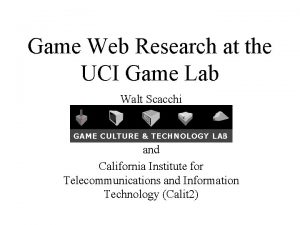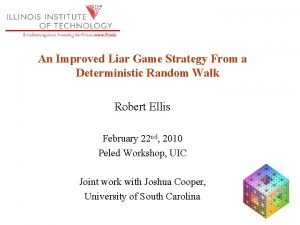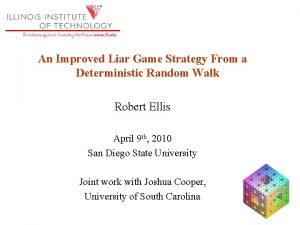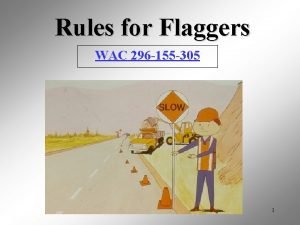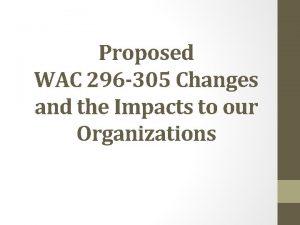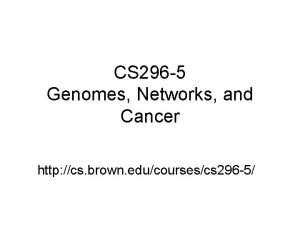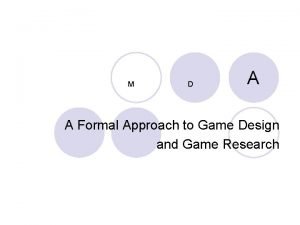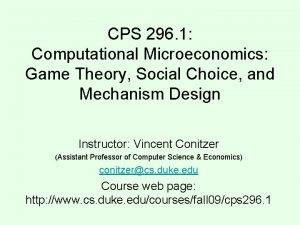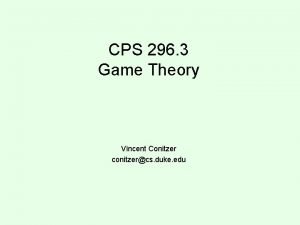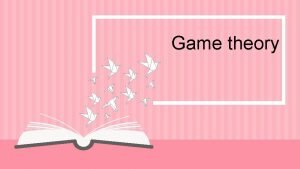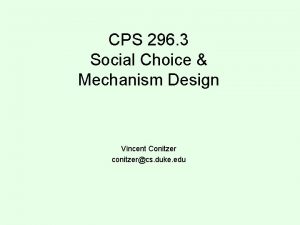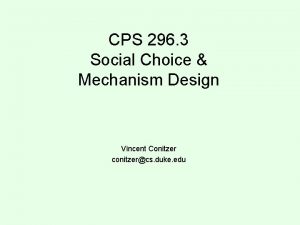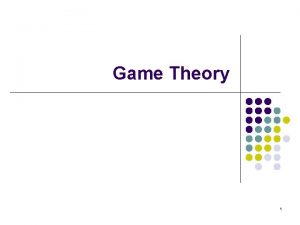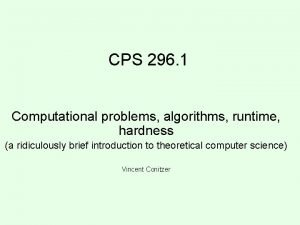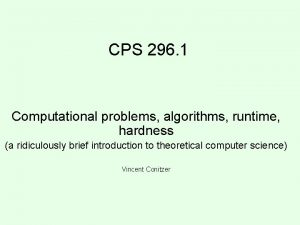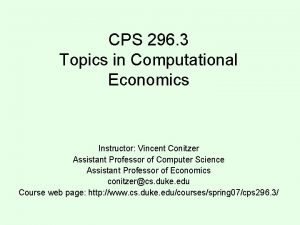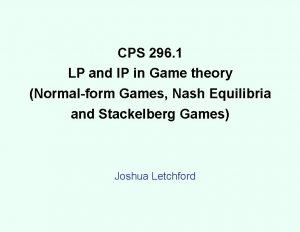CPS 296 2 Computational Game Theory and Mechanism

















- Slides: 17

CPS 296. 2 Computational Game Theory and Mechanism Design Instructor: Vincent Conitzer Assistant Professor of Computer Science Assistant Professor of Economics conitzer@cs. duke. edu Course web page: http: //www. cs. duke. edu/courses/fall 06/cps 296. 2/

What is game theory? • Game theory studies settings where multiple parties (agents) each have – different preferences (utility functions), – different actions that they can take • Each agent’s utility (potentially) depends on all agents’ actions – What is optimal for one agent depends on what other agents do • Very circular! • Game theory studies how agents can rationally form beliefs over what other agents will do, and (hence) how agents should act – Useful for acting as well as predicting behavior of others

Penalty kick example probability. 7 probability. 3 action probability 1 action probability. 6 probability. 4 Is this a “rational” outcome? If not, what is?

Where is game theory used? • Economics (& business) – Auctions, exchanges, price/quantity setting by firms, bargaining, funding public goods, … • Political science – Voting, candidate positioning, … • Biology – Stable proportions of species, sexes, behaviors, … • Philosophy – Conventions, ethics, … • And of course… Computer science! – Game playing programs, electronic marketplaces, networked systems, … – Computing the solutions that game theory prescribes

A brief history of game theory • Some isolated early instances of what we would now call game-theoretic reasoning – e. g. Haldegrave 1713, Cournot 1838 • von Neumann wrote a key paper in 1928 • 1944: Theory of Games and Economic Behavior by von Neumann and Morgenstern • 1950: Nash invents concept of Nash equilibrium • Game theory booms after this… • 1994: Harsanyi, Nash, and Selten win Nobel Prize in economics for game theory work • 2005: Aumann and Schelling win Nobel Prize in economics for game theory work

Game playing (& AI) perfect information games: no uncertainty about the state of the game (e. g. chess, Go) imperfect information games: uncertainty about the state of the game (e. g. poker) “nature” white Qa 1 -a 8 1 gets King Qa 1 -f 6 black Kf 8 -f 7 player 1 black Kf 8 -g 7 Kf 8 -g 8 1 gets Queen player 1 bet stay Kf 8 -e 8 player 2 black wins white wins • • • draw Optimal play: value of each node = value of optimal child for current player (backward induction, minimax) For chess and Go, tree is too large • player 2 call fold 2 1 call 1 fold call fold 1 1 1 -2 -1 Player 2 cannot distinguish nodes connected by dotted lines – Backward induction fails; need more sophisticated game-theoretic techniques for optimal play – Use other techniques (heuristics, limited-depth search, alpha-beta, …) • • Top computer programs (arguably) better than humans in chess, not yet in Go • Small poker variants can be solved optimally Humans still better than top computer programs a full-scale poker AAAI-06 computer poker competition: top programs all use game-theoretic techniques

Trading agents • Idea: given appropriate (e. g. web-based) interfaces, software can automatically make buying and selling decisions, matching supply to demand – Note: optimal action depends on what other (software, human) trading agents do → game theory • Lot of automated trading in financial markets – Academic interest in financial markets too: e. g. Penn-Lehman Automated Trading Project • Academic competitions: TAC (Trading Agent Competition)

TAC Classic • Software travel agents put together travel packages for clients – Agents compete in markets for flights, hotels, entertainment – Goal is to maximize own clients’ utilities

TAC Supply Chain Management • Agents manage a computer assembly supply chain – Compete for components from suppliers as well as customers – Agents have limited-capacity assembly lines – Goal is to maximize amount of money in the bank

What is mechanism design? • In mechanism design, we get to design the game (or mechanism) – e. g. the rules of the auction, marketplace, election, … • Goal is to obtain good outcomes when agents behave strategically (game-theoretically) • Mechanism design often considered part of game theory • Sometimes called “inverse game theory” – In game theory the game is given and we have to figure out how to act – In mechanism design we know how we would like the agents to act and have to figure out the game • The mechanism-design part of this course will also consider non-strategic aspects of mechanisms – E. g. computational feasibility

Example: (single-item) auctions • Sealed-bid auction: every bidder submits bid in a sealed envelope • First-price sealed-bid auction: highest bid wins, pays amount of own bid • Second-price sealed-bid auction: highest bid wins, pays amount of second-highest bid 1: $10 bid 2: $5 bid 3: $1 0 first-price: bid 1 wins, pays $10 second-price: bid 1 wins, pays $5

Which auction generates more revenue? • Each bid depends on – bidder’s true valuation for the item (utility = valuation - payment), – bidder’s beliefs over what others will bid (→ game theory), – and. . . the auction mechanism used • In a first-price auction, it does not make sense to bid your true valuation – Even if you win, your utility will be 0… • In a second-price auction, (we will see later that) it always makes sense to bid your true valuation bid 1: $10 a likely outcome for the first-price mechanism bid 1: $5 a likely outcome for the secondprice mechanism bid 2: $4 bid 3: $1 0 bid 2: $5 bid 3: $1 0 Are there other auctions that perform better? How do we know when we have found the best one?

Combinatorial auctions Simultaneously for sale: , , bid 1 v( ) = $500 bid 2 v( ) = $700 bid 3 v( ) = $300 used in truckload transportation, industrial procurement, radio spectrum allocation, …

Combinatorial auction problems • Winner determination problem – Deciding which bids win is (in general) a hard computational problem (NP-hard) • Preference elicitation (communication) problem – In general, each bidder may have a different value for each bundle – But it may be impractical to bid on every bundle (there are exponentially many bundles) • Mechanism design problem – How do we get the bidders to behave so that we get good outcomes? • These problems interact in nontrivial ways – E. g. limited computational or communication capacity limits mechanism design options

Voting over outcomes > > voting rule (mechanism) determines winner based on votes • Can vote over other things too – Where to go for dinner tonight, other joint plans, … • Many different rules exist for selecting the winner • Again, winner determination, elicitation, mechanism design problems

Routing & network design • Suppose that: – – – Units of traffic are infinitesimal, A traffic unit can choose any path from source S to destination D, A traffic unit’s cost is the sum of the costs of the edges it travels on, A traffic unit (selfishly) tries to minimize its own cost, Each edge’s cost c is a nondecreasing function of the total amount of traffic on it (congestion), – Total amount of traffic = 1 (by normalization) Braess’ Paradox (carelessly adding capacity can actually be hurtful!) A c(x) = 1 S c(x) = x A c(x) = x D c(x) = 1 B Game-theoretically optimal behavior: ½ goes through A, ½ goes through B, everyone has cost 1. 5 c(x) = 1 S c(x) = 0 c(x) = x D c(x) = 1 B Game-theoretically optimal behavior: everyone goes through BA, everyone has cost 2!

Yet another TAC competition: CAT • Participants set rules for matching buyers and sellers, and charging commissions – Trading agents (buyers, sellers) coded up by organizers – Commissions must be reasonable to attract traders • First iteration of competition will be in 2007 • CAT = – 1. reverse of TAC – 2. catallactics = the science of exchanges
 The pirate game
The pirate game Game lab game theory
Game lab game theory Liar game game theory
Liar game game theory Liar game game theory
Liar game game theory Game theory and graph theory
Game theory and graph theory Wac 296-155-305
Wac 296-155-305 Wac 296-800-160
Wac 296-800-160 Wac 296-305
Wac 296-305 Nnpj-296
Nnpj-296 Sos mihai bravu 296
Sos mihai bravu 296 Wac 296-305
Wac 296-305 E 296
E 296 Wac 296
Wac 296 Wac 296-307
Wac 296-307 Cs 296
Cs 296 A formal approach to game design and game research
A formal approach to game design and game research Computational thinking algorithms and programming
Computational thinking algorithms and programming Using mathematics and computational thinking
Using mathematics and computational thinking

